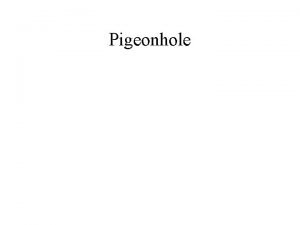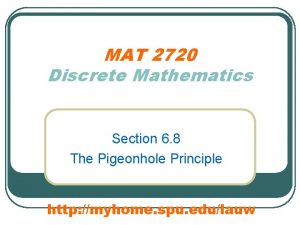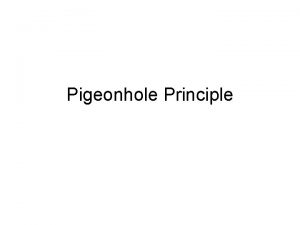The Pigeonhole Principle Selected Exercises The PigeonHole Principle










- Slides: 10

The Pigeonhole Principle: Selected Exercises

The Pigeon-Hole Principle Let k be a positive integer. If k + 1 or more objects are placed in k boxes, Then at least 1 box contains 2 or more objects. Copyright © Peter Cappello 2

Exercise 10 Let ( xi, yi ), i = 1, 2, 3, 4, 5, be a set of 5 distinct points with integer coordinates in the xy plane. Show that the midpoint of the line joining at least 1 pair of these points has integer coordinates. (x 1, y 1) ( (x 1+ x 2 )/2 , (y 1+ y 2 )/2 ) (x , y ) Copyright © 2 Peter 2 Cappello 2011 3

Exercise 10 Solution 1. (xj + xi)/2 is integer if xj & xi are both odd or both even. 2. (yj + yi)/2 is integer if yj & yi are both odd or both even. 3. Put each ordered pair into 2 x 2 = 4 categories: 1. x odd, y odd 2. x odd, y even 3. x even, y odd 4. x even, y even 4. With 5 distinct ordered pairs, at least 1 category has ≥ 2 points. A line connecting 2 points in the same category has a midpoint with integer coordinates. Copyright © Peter Cappello 4

Exercise 30 Show: If there are 100, 000 wage earners in the US who earn < $1, 000, there are 2 with the same income, to the penny. (Assume each wage earner’s income > 0. ) Copyright © Peter Cappello 5

Exercise 30 Solution Show that if there are 100, 000 wage earners in the US who earn < $1, 000, there are 2 with the same income, to the penny. Solution: 1. Assume that each income is > 0. 2. Denominate the incomes in pennies. 3. The smallest possible income is 1¢. 4. The largest possible income is $999, 999. 99 = 99, 999¢. 5. Since there are more wage earners (100, 000) than distinct income values (99, 999), at least 2 must earn the same income. Copyright © Peter Cappello 6

Exercise 40 There are 51 houses on a street. Each house has an integer address between 1000 and 1099, inclusive. Show that at least 2 houses have consecutive addresses. Copyright © Peter Cappello 7

Exercise 40 Solution There are 51 houses on a street. Each house has an integer address between 1000 and 1099, inclusive. Show that at least 2 houses have consecutive addresses. Solution: 1. Partition the address space into 50 intervals: [1000, 1001], [1002, 1003], …, [1098, 1099]. • Associate each of the 51 addresses with an interval. • There are more addresses than intervals. • At least 1 interval is associated with 2 distinct addresses. Copyright © Peter Cappello 8

End Copyright © Peter Cappello 9

20 Find an increasing subsequence of maximal length and a decreasing subsequence of maximal length in the sequence 22, 5, 7, 2, 23, 10, 15, 21, 3, 17. Solution: Brute force. 5, 7, 10, 15, 21 is an increasing subsequence of length 5. 22, 10, 3 is a decreasing subsequence of length 3 (not unique). Copyright © Peter Cappello 10
 Pigeonhole principle exercises
Pigeonhole principle exercises Pigeonhole principle examples
Pigeonhole principle examples State the pigeonhole principle
State the pigeonhole principle Application of pigeonhole principle
Application of pigeonhole principle Pigeonhole principle
Pigeonhole principle Dirichlet box principle
Dirichlet box principle Pigeonhole principle
Pigeonhole principle Pumping lemma pigeonhole principle
Pumping lemma pigeonhole principle Pigeonhole principle proof
Pigeonhole principle proof Dirichlet's box principle
Dirichlet's box principle Pigeonhole principle in discrete mathematics
Pigeonhole principle in discrete mathematics














